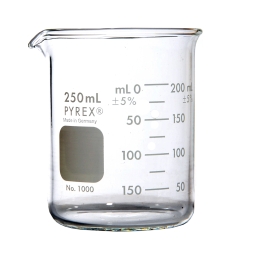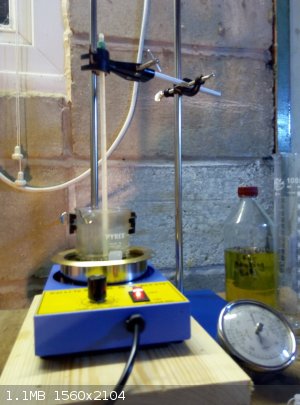zombiedude1
Harmless

Posts: 36
Registered: 15-10-2015
Member Is Offline
Mood: No Mood
|
|
How efficient is your hotplate? (Experiment!)
This topic is a public experiment to determine & compare hotplate efficiency.
The control being H2O.
When posting, please include the following format.
Please use tap water & feel free to label ppm as well. (Save your precious distilled/reverse osmosis water)
Format:
Hotplate Time:
Ambient Temperature:
Ambient Relative Humidity:
Starting Water Temperature:
H2O ppm: (Optional)
Hotplate Price:
Hotplate Brand/Model:
Hotplate Top Dimensions (inches):
Hotplate Top:
Hotplate Wattage:
Magnetic Stirrer (Y/N):
(Hotplate top can be ceramic, aluminum, etc..)
Variables:
Attempt to maintain these variables before conducting this experiment:
Ambient Temperature: 22.5C (Approx. 72F)
Ambient Relative Humidity: 50%
H2O Temperature: 21C (Approx. 70F)
INSTRUCTIONS:
(Ensure hotplate is cold, and has been sitting in room temperature)
1. Start filling out the format as much as possible before starting.
2. Prepare hotplate and beaker (Clean/dry)
3. Fill 250ml pyrex beaker with 150ml of H2O.
4. Place pyrex beaker containing H2O on the center of the cold hotplate.
5. Place thermometer inside beaker.
6. Note time, turn on hotplate with the highest temperature setting.
NOTE: DO NOT STIR/AVOID CREATING WIND/DRAFTS
7. When water reaches 100C, note the current time. Turn off hotplate.
8. Fill out the rest of the format & post response!
(Hotplate time is how long it took to reach 100C)
Please use a 250ml Pyrex Beaker for this experiment

This may just be measuring the thermal conductivity of your hotplate and there are better ways to measure efficiency, however; this is a simple form
of an experiment for the community to participate in.
I look forward to seeing your results!
[Edited on 26-10-2015 by zombiedude1]
[Edited on 26-10-2015 by zombiedude1]
|
|
|
zombiedude1
Harmless

Posts: 36
Registered: 15-10-2015
Member Is Offline
Mood: No Mood
|
|
Here's an example of a test I just ran with my hotplate.
Hotplate Time: 13:30 (13min, 30sec)
Ambient Temperature: 22.5C
Ambient Relative Humidity: 60%
Starting Water Temperature: 21C
H2O ppm: 80
Hotplate Price: $80 (Ebay)
Hotplate Brand/Model: VWR Model 320
Hotplate Top Dimensions (inches): 7"x7"
Hotplate Top: Ceramic
Hotplate Wattage: 865
Magnetic Stirrer (Y/N): Y
[Edited on 26-10-2015 by zombiedude1]
|
|
|
bob800
Hazard to Others
  
Posts: 240
Registered: 28-7-2010
Member Is Offline
Mood: No Mood
|
|
Quote: Originally posted by zombiedude1  | | This may just be measuring the thermal conductivity of your hotplate and there are better ways to measure efficiency, however; this is a simple form
of an experiment for the community to participate in. |
Yes, since isn't the "efficiency" in terms of (electrical power in / thermal power out) of a resistive heating element always 100%? Nonetheless I like
the concept of your community data-collection idea.
|
|
|
Varmint
Hazard to Others
  
Posts: 264
Registered: 30-5-2013
Location: Near Atlanta, GA
Member Is Offline
Mood: No Mood
|
|
The real problem as I see it is the flatness of your beaker's bottom. I've done a test like this in the past, I don't recall the time to boil, but I
do recall is there was 7 minutes difference between two "identical" Corning Pryrex beakers.
With a shot of oil underneath both, the time to boil was radically reduced, and the spread between the two dropped to under a minute.
The point is, testing is about eliminating variables, or at least understanding them.
Unless you can standardize the vessel, you will have wild variations.
|
|
|
zombiedude1
Harmless

Posts: 36
Registered: 15-10-2015
Member Is Offline
Mood: No Mood
|
|
A 7 minute difference between the two? Wow. I wouldn't see the flatness of the pyrex beaker being much of an issue (I'd assume any lab glass for
measurements would be made with quality standards), I would see the hotplate flatness being more of an issue with this experiment.
And yes, I expect to have a variations but nothing extremely wild as long as the conditions are correct.
Having movement between the beaker and hotplate through an uneven bottom sounds like it would make a drastic change in the boil time.
If we have enough people conduct the experiment, maybe some will learn there is something wrong with the flatness of one of their beakers (as
mentioned); or they are having bad conductivity with their hotplates, It's great to test and compare.
|
|
|
Sulaiman
International Hazard
    
Posts: 3558
Registered: 8-2-2015
Location: 3rd rock from the sun
Member Is Offline
|
|
Since each persons setup will have a different thermal mass
a comparison by time-to-boil will not be very useful,
a better measure would be the rate of water boiling off,
e.g.
weigh water + container,
bring to boil, start timing,
stop timing when about half of the water has boiled away,
allow to cool, weigh water + container.
Power (W) = weight of water boiled off (grammes) x 2270 / time (seconds)
since water = 1g = 1cc = 1 ml,
this test can be done with either weighing scales or a measuring cylinder.
Some of the water vapor will condense inside the container,
so this represents a real life figure for how much liquid can be boiled and used in the vapour phase (distillation / evaporation etc.) in your actual
setup.
I will have a go myself in the next few days .....
[Edited on 27-10-2015 by Sulaiman]
|
|
|
Praxichys
International Hazard
    
Posts: 1063
Registered: 31-7-2013
Location: Detroit, Michigan, USA
Member Is Offline
Mood: Coprecipitated
|
|
You can easily calculate how much energy is being given to the water vs the wattage of the hotplate, giving efficiency.
Specific heat of water from ~20-100C = 4.19 (kJ/(kg K))
We'll use zombiedude1's data as an example:
Ti = 296K
Tf = 373K
mH2O = 150g
t = 420s
Wattage = 865W
Joules given to water = (373-296)*4190/150 = 2150
Watts (J/s) given to water = 2150/420 = 5.12W
Efficiency = 0.592%
Keep in mind that resistive heating elements change their resistance with temperature, and thus will use their maximum power when cold. Also, power
cycling to prevent overheating may be a factor.
This efficiency calculation is nice because it encompasses the entire system - beaker contact, plate flatness, thermal mass of the plate, etc. and
compares it against the maximum power draw.
Also, if you're worried about boiling things quickly, just get a lab microwave. I got one for $5 at the local thrift store. It'll boil 150ml in about
a minute. I use it all the time. I would consider it one of my most used pieces of equipment.
|
|
|
Sulaiman
International Hazard
    
Posts: 3558
Registered: 8-2-2015
Location: 3rd rock from the sun
Member Is Offline
|
|
Praxichys;
Joules given to water = (373-296)*4190/150 = 2150
Watts (J/s) given to water = 2150/420 = 5.12W
Efficiency = 0.592%
OR
Joules given to water = (373 - 294) x 4190 x 0.150 = 49651.5 J
Watts = 49651.5 / 810 = 61.3 W = 7.0865 % efficiency
WAKEY WAKEY !
|
|
|
Praxichys
International Hazard
    
Posts: 1063
Registered: 31-7-2013
Location: Detroit, Michigan, USA
Member Is Offline
Mood: Coprecipitated
|
|
Damn! I suck today. 
|
|
|
Sulaiman
International Hazard
    
Posts: 3558
Registered: 8-2-2015
Location: 3rd rock from the sun
Member Is Offline
|
|
My first test;
Ka Li Te KLT-310 100mm dia. 300W Solder Pot.
http://www.ebay.co.uk/itm/171177567059?_trksid=p2057872.m274...
Setup;
(does not really need a photograph, just wanted to show off my new retort stands and clamps 

KLT-310 as an oil (olive) bath, power set to HI = maximum
250 ml Pyrex beaker
-10 to +110 C thermometer, 1 C graduations, not calibrated.
Ambient temperature 18 C, pressure 29.61" Hg
100 ml of distilled water put in beaker
Time / Water Temp. / comment
8:53 / 16.0 / Power ON
8:57 / 33.5 /
8:58 / 48.0 /
8:59 / 64.0 /
9:00 / 79.5 /
9:02 / 100.0 / boiling
9:12 / 100.0 / Power OFF, 44ml water remaining.
...........................................................................
So,
time to heat 100 ml of water with a starting temperature of 16 C to 100 C = 9 minutes = 540 seconds
time to boil off 56 ml of water = 10 min. = 600 seconds.
some math ....
Method 1 ... rate of rise of temperature:
(100 - 16) x 4187 x 0.1 = 35,171 J
35,171 / 540 = 65.13 Watts effective heating power
Method 2 ... rate of evaporation of water:
(100 - 44) x 2,270 = 127,120 J
127,120 / 600 = 212 Watts effective evaporating power
Both measurements are useful but I thing the thermal inertia of the heater/oil/beaker appear to have a significant effect in method 1.
Observations;
tiny splashes of water could occasionally be heard sizzling in the oil or on the lip of the heater,
unexpected water loss results in an over estimate of power,
but I estimate that it was very small quantity.
The thermometer went up to 103 C !
could be thermometer error, insufficient immersion or superheating due to no boiling chips or stirring.
not enough boss clamps to hold a second thermometer so oil temp not measured, the oil did not smoke.
[Edited on 27-10-2015 by Sulaiman]
[Edited on 27-10-2015 by Sulaiman]
|
|
|
zombiedude1
Harmless

Posts: 36
Registered: 15-10-2015
Member Is Offline
Mood: No Mood
|
|
You guys obviously came up with a more accurate analysis  . .
Even though the original format was not followed, it's still very interesting to see the results of these tests. Good job Sulaiman! Can't wait to see
more.
However, I think you should create a new topic with your method and this one should be forgotten; since it's created by a novice 
P.S.
- You should really check out your local metal supply warehouse, my local one supplies 12ft of 3/8" Stainless Steel rods for $12. Much cheaper than
purchasing retort stands.
(I bought two stands for approx $50 + the clamps/rings (+$30), and realized I could have easily welded my own together, so I went out and got some
rods)
[Edited on 28-10-2015 by zombiedude1]
|
|
|
JJay
International Hazard
    
Posts: 3440
Registered: 15-10-2015
Member Is Offline
|
|
I fractionally distilled water last night. I used a 2L soybean oil bath with a 500 watt immersion heater, placing approximately 250 mL of water in a
500 mL boiling flask and running the vapors though a 30mm Vigreux column before the condenser. I took my time.
Fractional Distillation of Water Temperature Log
A: Time
B: Power Level (1-7)
C: Soybean Oil Bath Temperature (C)
D: Temperature at Condenser (C)
E: Notes
A B C D E
2215 0 53 28.4 Turning on with heat at 4.
2220 4 54 28.5
2222 4 59 29.1
2226 4 68 28.6 Turned on water to condenser
2231 4 78 29.1
2234 4 86 29.6 Moved heating element slightly to keep away from glass
2240 4 94 30.2
2243 4 99 30.0
2245 4 102 30.0 Starting to see bubbles in the water
2251 4 110 30.7
2253 4 116 31.1 Boiling started
2258 4 120 65 Temperature at condenser rising rapidly
2302 4 123 87
2305 4 125 100.4
2306 4 126 101.1 First drop distilled over
2321 4 132 102.1 Distillation is going pretty slow; perhaps 5 mL have distilled so far.
2330 4 134 102.2 Distillation is going slightly faster but still pretty slow.
2341 4 134 101.7 Increasing heat to 5.
2352 5 141 101.9
2356 5 144 101.7
0003 5 144 101.5
0007 5 145 101.7
0012 5 148 101.8
0017 5 149 101.9
0023 5 149 101.8
0024 Approximately 100 mL water collected. Terminating experiment.
What is interesting about this is that I also had high steam temperature readings--some above 102. I'm thinking I'll test the thermometer with ice
water to see if perhaps it is reading incorrectly.
Note: Log edited to reflect 24 hr time for all entries.
[Edited on 28-10-2015 by JJay]
|
|
|